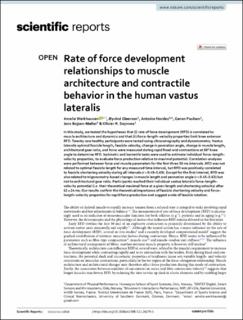| dc.contributor.author | Werkhausen, Amelie | |
| dc.contributor.author | Gløersen, Øyvind Nøstdahl | |
| dc.contributor.author | Nordez, Antoine | |
| dc.contributor.author | Paulsen, Gøran | |
| dc.contributor.author | Bojsen-Møller, Jens | |
| dc.contributor.author | Seynnes, Olivier R. | |
| dc.date.accessioned | 2023-03-02T14:25:52Z | |
| dc.date.available | 2023-03-02T14:25:52Z | |
| dc.date.created | 2023-01-02T18:27:57Z | |
| dc.date.issued | 2022 | |
| dc.identifier.citation | Scientific Reports. 2022, 12(2022), Artikkel 21816. | en_US |
| dc.identifier.issn | 2045-2322 | |
| dc.identifier.uri | https://hdl.handle.net/11250/3055480 | |
| dc.description | This article is licensed under a Creative Commons Attribution 4.0 International License, which permits use, sharing, adaptation, distribution and reproduction in any medium or format, as long as you give appropriate credit to the original author(s) and the source, provide a link to the Creative Commons licence, and indicate if changes were made. The images or other third party material in this article are included in the article's Creative Commons licence, unless indicated otherwise in a credit line to the material. If material is not included in the article's Creative Commons licence and your intended use is not permitted by statutory regulation or exceeds the permitted use, you will need to obtain permission directly from the copyright holder. | en_US |
| dc.description.abstract | In this study, we tested the hypotheses that (i) rate of force development (RFD) is correlated to muscle architecture and dynamics and that (ii) force–length–velocity properties limit knee extensor RFD. Twenty-one healthy participants were tested using ultrasonography and dynamometry. Vastus lateralis optimal fascicle length, fascicle velocity, change in pennation angle, change in muscle length, architectural gear ratio, and force were measured during rapid fixed-end contractions at 60° knee angle to determine RFD. Isokinetic and isometric tests were used to estimate individual force–length–velocity properties, to evaluate force production relative to maximal potential. Correlation analyses were performed between force and muscle parameters for the first three 50 ms intervals. RFD was not related to optimal fascicle length for any measured time interval, but RFD was positively correlated to fascicle shortening velocity during all intervals (r = 0.49–0.69). Except for the first interval, RFD was also related to trigonometry-based changes in muscle length and pennation angle (r = 0.45–0.63) but not to architectural gear ratio. Participants reached their individual vastus lateralis force–length–velocity potential (i.e. their theoretical maximal force at a given length and shortening velocity) after 62 ± 24 ms. Our results confirm the theoretical importance of fascicle shortening velocity and force–length–velocity properties for rapid force production and suggest a role of fascicle rotation. | en_US |
| dc.language.iso | eng | en_US |
| dc.subject | muscle | en_US |
| dc.subject | physiology | en_US |
| dc.title | Rate of force development relationships to muscle architecture and contractile behavior in the human vastus lateralis | en_US |
| dc.type | Peer reviewed | en_US |
| dc.type | Journal article | en_US |
| dc.description.version | publishedVersion | en_US |
| dc.rights.holder | © The Author(s) 2022 | en_US |
| dc.source.pagenumber | 9 | en_US |
| dc.source.volume | 12 | en_US |
| dc.source.journal | Scientific Reports | en_US |
| dc.identifier.doi | 10.1038/s41598-022-26379-5 | |
| dc.identifier.cristin | 2099181 | |
| dc.description.localcode | Institutt for fysisk prestasjonsevne / Department of Physical Performance | en_US |
| dc.source.articlenumber | 21816 | en_US |
| cristin.ispublished | true | |
| cristin.fulltext | original | |
| cristin.qualitycode | 1 | |
